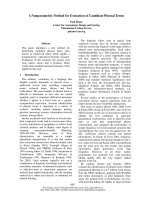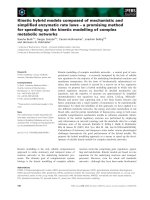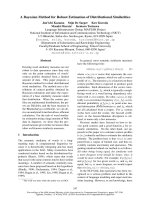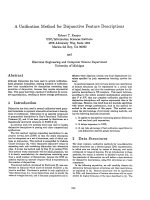5. A regularization method for backward parabolic equations with time-dependent coefficients
Bạn đang xem bản rút gọn của tài liệu. Xem và tải ngay bản đầy đủ của tài liệu tại đây (186.56 KB, 9 trang )
<span class='text_page_counter'>(1)</span><div class='page_container' data-page=1>
A REGULARIZATION METHOD FOR BACKWARD
PARABOLIC EQUATIONS WITH TIME-DEPENDENT COEFFICIENTS
Nguyen Van Duc (1), Tran Hoai Bao (2)
1 <sub>School of Natural Sciences Education, Vinh University, Vinh City, Vietnam</sub>
2 <sub>Ha Tinh High School for the Gifted, Ha Tinh City, Vietnam</sub>
Received on 19/5/2019, accepted for publication on 15/7/2019
Abstract: Let H be a Hilbert space with the norm k · k and A(t),(06t 6T)
be positive self-adjoint unbounded operators from D(A(t)) ⊂ H to H. In the
paper, we propose a regularization method for the ill-posed backward parabolic
equation with time-dependent coefficients
(
ut+A(t)u= 0, 0< t < T,
ku(T)−fk<sub>6</sub>ε, f ∈H, ε >0.
A priori and a posteriori parameter choice rules are suggested which yield errors
estimates of Hăolder type. Our errors estimates improve the related results in [4].
1
Introduction
LetH be a Hilbert space equipped the inner producth·,·iand the normk · k,A(t) (0<sub>6</sub>
t6T) :D(A(t))⊂H→H be positive self-adjoint unbounded operators onH. Letf inH
andε be a given positive number. We consider the backward parabolic problem of finding
a functionu: [0, T]→H such that
(
ut+A(t)u= 0, 0< t < T,
ku(T)−fk<sub>6</sub>ε. (1)
This problem is well-known to be severely ill-posed [8], [9]. Therefore, the stability
estimates and the regularization methods [11] are required.
It was proved in [4] that, ifu(t) is a solution of the equationut+A(t)u= 0, 0< t < T,
then there exists a non-negative functionν(t) on [0, T]such that
ku(t)k<sub>6</sub>cku(T)kν(t)ku(0)k1−ν(t), ∀t∈[0, T], (2)
wherecis a positive constant. Furthermore, a priori and a posteriori parameter choice rules
were suggested yielding the errors estimates of Hăolder type with an order (<sub>2</sub>t). In this paper,
we investigate the regularization of the problem (1). The main tools will be based on the
method of non-local boundary value problems [1]-[6] and the parameter choice rules of a
priori and a posteriori. We then proved that these parameter choice rules yield the errors
estimates of Hăolder type with an order(t). This is an improvement of the related results
in [4].
1)
</div>
<span class='text_page_counter'>(2)</span><div class='page_container' data-page=2>
2
Preliminaries
Let us recall the following result from Theorem 2.5 in [4].
Suppose that
(i) A(t) is a self-adjoint operator for eacht, and u(t) belongs to domain of A(t)
(ii) If u(t) is a solution of the equation
Lu:= du
dt +A(t)u= 0, 0< t6T
then for some non-negative constantsk, c, it holds that
−d
dthA(t)u(t), u(t)i>2kA(t)uk
2<sub>−</sub><sub>c</sub><sub>h</sub><sub>(</sub><sub>A</sub><sub>(</sub><sub>t</sub><sub>) +</sub><sub>k</sub><sub>)</sub><sub>u</sub><sub>(</sub><sub>t</sub><sub>)</sub><sub>, u</sub><sub>(</sub><sub>t</sub><sub>)</sub><sub>i</sub><sub>.</sub>
Leta1(t) be a continuous function on[0, T]satisfying a1(t)6c,∀t∈[0, T]and
−d
dthA(t)u(t), u(t)i>2kA(t)uk
2<sub>−</sub><sub>a</sub>
1(t)h(A(t) +k)u(t), u(t)i.
For allt∈[0, T], let
a2(t) = exp
Z t
0
a1(τ)dτ
, a3(t) =
Z t
0
a2(ξ)dξ,
ν(t) = a3(t)
a3(T)
. (3)
Then
ku(t)k<sub>6</sub>ekt−kT ν(t)ku(T)kν(t)<sub>ku</sub><sub>(0)</sub><sub>k</sub>1−ν(t)<sub>,</sub> <sub>∀t</sub><sub>∈</sub><sub>[0</sub><sub>, T</sub><sub>]</sub><sub>.</sub> <sub>(4)</sub>
3
Main results
In this section, we make the following assumptions for the operatorsA(t) [12; pp.
134-135].
(H1) For06t6T, the spectrum ofA(t)is contained in a sectorial open domain
σ(A(t))⊂Σω={λ∈C; |argλ|< ω}, 06t6T, (5)
with some fixed angle0< ω < π<sub>2</sub>, and the resolvent satisfies the estimate
k(λ−A(t))−1k<sub>6</sub> M
|λ|, λ6∈Σω, 06t6T, (6)
with some constantM >1.
(H2) The domainD(A(t))is independent of tand A(t) is strongly continuously
differ-entiable [10; p. 15].
(H3) For all t∈[0, T],A(t) is a positive self-adjoint unbounded operator and ifu(t) is
a solution of the equationLu= du
dt +A(t)u= 0, 0< t6T, then there are a non-negative
constantkand a continuous function on[0, T],a1(t)such that
−d
dthA(t)u(t), u(t)i>2kA(t)uk
2<sub>−</sub><sub>a</sub>
</div>
<span class='text_page_counter'>(3)</span><div class='page_container' data-page=3>
Remark 3.1. (See [4]) If assumptions (H1) and(H2) are satisfied, then
kA(t)(A(t)−1−A(s)−1)k<sub>6</sub>N|t−s|, 06s, t6T, (8)
for some constantN >0.
To regularize (1), following Fritz John [7], we should impose some prescribed bound for
u(0). Namely, in this section we suppose that there is a positive constantE such that
ku(0)k<sub>6</sub>E. (9)
Now, let
B(t) =
(
A(−t), if −T 6t60,
A(t), if0< t6T. (10)
ThenB(t) =B(−t),∀t∈[−T, T]. Furthermore, B(t), (−T <sub>6</sub>t6T) are also positive
self-adjoint unbounded operators, the domain D(B(t)) is independent of t and B(t), (−T <sub>6</sub>
t6T) also satisfy the conditions (5), (6) and (8).
In this paper, the ill-posed parabolic equation backward in time (1) subjects to the
constraint (9), is regularized by the problem
(
vt+B(t)v= 0, −T < t < T,
αv(−T) +v(T) =f, (11)
whereα is a positive number.
From now on, for clarity, we denote the solution of (1), (9) by u(t), the solution of the
problem (11) byv(t)and z(t) =u(t)−v(t), ∀t∈[0, T]. We havez(t) is the solution of the
problem
(
zt+A(t)z= 0, 0< t < T,
z(0) =u(0)−v(0). (12)
Theorem 3.2. The problem (11) is well-posed.
Proof. The proof of this theorem is an application of Lemma 3.3 and Lemma 3.4 below.
Lemma 3.3. If v(t) is a solution of (11), then
α2kv(−T)k2+ (2α+ 1)kv(T)k2<sub>6</sub>kfk2
and
kv(t)k<sub>6</sub> 1
αkfk,∀t∈[−T, T].
Proof. We have
kfk2=hαv(−T) +v(T), αv(−T) +v(T)i
</div>
<span class='text_page_counter'>(4)</span><div class='page_container' data-page=4>
Seth(t) :=hv(−t), v(t)i, t∈[−T, T]. We see that
h0(t) = 0,∀t∈(−T, T).
Therefore,his a constant. This implies thath(0) =h(T). Thus,hv(−T), v(T)i=kv(0)k2.
Set p(t) := kv(t)k2<sub>,</sub> <sub>t</sub><sub>∈</sub> <sub>[</sub><sub>−T, T</sub><sub>]</sub><sub>. Then</sub> <sub>p</sub>0<sub>(</sub><sub>t</sub><sub>) =</sub> <sub>−</sub><sub>2</sub><sub>hB</sub><sub>(</sub><sub>t</sub><sub>)</sub><sub>v</sub><sub>(</sub><sub>t</sub><sub>)</sub><sub>, v</sub><sub>(</sub><sub>t</sub><sub>)</sub><sub>i</sub>
60, ∀t∈ (−T, T).
This implies thatp(0)>p(T). Therefore,
hv(−T), v(T)i=kv(0)k2 <sub>></sub>kv(T)k2.
It follows from (13) and the positivity ofα that
kfk2 <sub>></sub>α2kv(−T)k2+ (2α+ 1)kv(T)k2.
On the other hand, we havekv(t)k2 <sub>=</sub><sub>p</sub><sub>(</sub><sub>t</sub><sub>)</sub><sub>6</sub><sub>p</sub><sub>(</sub><sub>−T</sub><sub>) =</sub> <sub>kv</sub><sub>(</sub><sub>−T</sub><sub>)</sub><sub>k</sub>2<sub>,</sub><sub>∀t</sub><sub>∈</sub> <sub>[</sub><sub>−T, T</sub><sub>]</sub><sub>. Therefore</sub>
kv(t)k<sub>6</sub>kv(−T)k<sub>6</sub> 1
αkfk,∀t∈[−T, T].The lemma is proved.
Lemma 3.4. There exists a unique solution of the problem (11).
Proof. SinceB(t) (−T <sub>6</sub>t6T) satisfies the assumptions (5),(6) and (8), due to Theorem
3.9 in [12; p. 147], there exists an evolution operatorU(t) (−T <sub>6</sub>t6T)which is a bounded
linear operator onHsuch that ifv(t)is a solution of the problemvt+B(t)v= 0,−T < t < T,
thenv(t) =U(t)v(−T).
Leth(t) =hv(−t), v(t)i, ∀t∈[−T, T]. By direct calculation we see thath0(t) = 0,∀t∈
(−T, T). Therefore, h is a constant. This implies that h(T) =h(0). Thus,
hv(−T), v(T)i=hv(0), v(0)i
=kv(0)k2 <sub>></sub>0.
Therefore,
hU(T)v(−T), v(−T)i=hv(T), v(−T)i=kv(0)k2<sub>></sub>0.
This implies that the operatorU(T)is positive. Therefore the operatorαI+U(T)is
invert-ible for allα >0. Finally, setv(t) =U(t)(αI+U(T))−1f, t∈[−T, T], by direct calculation,
we see thatv(t) is a unique solution of the problem (11).
Theorem 3.5. The following inequality holds for all α >0
2α
kz(0)k −E
2
2
+kz(T)k2<sub>6</sub>ε2+αE
2
2 . (14)
Proof. Letq(t) =hv(−t), z(t)i, ∀t∈[0, T]. By direct calculation we see thatq0(t) = 0,∀t∈
(0, T). Therefore,q is a constant. This implies that q(T) =q(0). Thus,
hv(−T), z(T)i=hv(0), z(0)i.
We have
</div>
<span class='text_page_counter'>(5)</span><div class='page_container' data-page=5>
Therefore, we obtain
ε2+αE
2
2 >kf −u(T)k
2<sub>+</sub>αE2
2
=kαv(−T)−z(T)k2+ αE
2
2
=α2kv(−T)k2−2αhv(−T), z(T)i+kz(T)k2+αE
2
2
=α2kv(−T)k2−2αhv(0), z(0)i+kz(T)k2+αE
2
2
=α2kv(−T)k2+ 2αhz(0)−u(0), z(0)i+kz(T)k2+αE
2
2
=α2kv(−T)k2+ 2αkz(0)k2−2αhu(0), z(0)i+kz(T)k2+ αE
2
2
>2αkz(0)k2−2αhu(0), z(0)i+kz(T)k2+ αE
2
2
>2αkz(0)k2−2αku(0)kkz(0)k+kz(T)k2+ αE
2
2
>2αkz(0)k2−2αEkz(0)k+kz(T)k2+αE
2
2
= 2α
kz(0)k −E
2
2
+kz(T)k2<sub>.</sub>
The theorem is proved.
3.1 A priori parameter choice rule
Theorem 3.6. Suppose that u(t) is a solution of the problem (1) subjects to the constraint
(9), andv(t) is the solution of the problem (11). Then by choosing α=aε
E
2
, (a >0),
we obtain, for allt∈[0, T],
ku(t)−v(t)k ≤ekt−kT ν(t)
r
1 +a
2
ν(t)
1
2+
s
1
2
1
2 +
1
a
!1−ν(t)
εν(t)E1−ν(t),
where ν(t) is defined by (3). In the case of a= 1, we have
ku(t)−v(t)k ≤ 3
2e
kt−kT ν(t)<sub>ε</sub>ν(t)<sub>E</sub>1−ν(t)<sub>,</sub> <sub>∀t</sub><sub>∈</sub><sub>[0</sub><sub>, T</sub><sub>]</sub><sub>.</sub>
Proof. Using (4), we obtain
</div>
<span class='text_page_counter'>(6)</span><div class='page_container' data-page=6>
On the other hand, from (14) we have
kz(T)k2 <sub>6</sub><sub>2</sub><sub>α</sub>
kz(0)k −E
2
2
+kz(T)k2
6ε2+αE
2
2
=
1 +a
2
ε2
or
kz(T)k<sub>6</sub>ε
r
1 +a
2. (16)
Furthermore, we have
2α
kz(0)k −E
2
2
62α
kz(0)k −E
2
2
+kz(T)k2
6ε2+αE
2
2
= αE
2
a +
αE2
2 .
This implies that
kz(0)k −E
2
2
6 1
2
1
2+
1
a
E2.
Therefore
kz(0)k −E
2 6E
s
1
2
1
2 +
1
a
or
kz(0)k<sub>6</sub> 1
2+
s
1
2
1
2 +
1
a
!
E. (17)
The proposition of Theorem 3.6 follows immediately from (15), (16) and (17).
3.2 A posteriori parameter choice rule
In this section, we denote byvα(t)the solution of the problem (11).
Theorem 3.7. Suppose thatε <kfk. Then there exists a unique number αε>0such that
kvαε(T)−fk=ε. (18)
Further, if u(t) is a solution of the problem (1) satisfying (9), then
ku(t)−vα(t)k62
</div>
<span class='text_page_counter'>(7)</span><div class='page_container' data-page=7>
Proof. Let ρ(α) =kvα(T)−fk =αkvα(−T)k, ∀α >0. By similar argument as in [4], we
conclude that ρ is a continuous function, lim
α→0+ρ(α) = 0, α→lim+∞ρ(α) = kfk, and ρ is a
strictly increasing function. This implies that there exists a unique numberαε >0 which
satisfies (18).
We now establish error estimate of this method. Let z(t) =u(t)−vαε(t), t∈[0, T]. We
have
kz(T)k=ku(T)−vαε(T)k=k(u(T)−f)−(vαε(T)−f)k
6ku(T)−fk+kvαε(T)−fk62ε. (20)
Putgαε =vαε(−T). We have
αεgαε +vαε(T) =f
and
hg<sub>α</sub><sub>ε</sub>, z(T)i=hv<sub>α</sub><sub>ε</sub>(0), z(0)i
=hu(0)−z(0), z(0)i
=hu(0), z(0)i − kz(0)k2.
Therefore, we obtain
ε2+αεE
2
2 >kf−u(T)k
2<sub>+</sub>αεE2
2
=kαεgαε−z(T)k
2<sub>+</sub>αεE2
2
=α2<sub>ε</sub>kgαεk
2<sub>−</sub><sub>2</sub><sub>α</sub>
εhg, z(T)i+kz(T)k2+
αεE2
2
=ρ2(αε)−2αε hu(0), z(0)i − kz(0)k2
+kz(T)k2+αεE
2
2
=ε2+ 2αεkz(0)k2−2αεhu(0), z(0)i+kz(T)k2+
αεE2
2
>2αεkz(0)k2−2αεhu(0), z(0)i+
αεE2
2 +ε
2
>2αεkz(0)k2−2αεku(0)kkz(0)k+
αεE2
2 +ε
2
>2αε
kz(0)k −E
2
2
+ε2.
This implies that
2αε
kz(0)k −E
2
2
</div>
<span class='text_page_counter'>(8)</span><div class='page_container' data-page=8>
or
kz(0)k<sub>6</sub>E. (21)
From (4), (20) and (21), we have
ku(t)−vαε(t)k=kz(t)k6e
kt−kT ν(t)<sub>kz</sub><sub>(</sub><sub>T</sub><sub>)</sub><sub>k</sub>ν(t)<sub>kz</sub><sub>(0)</sub><sub>k</sub>1−ν(t)
6ekt−kT ν(t)(2ε)ν(t)E1−ν(t)
= 2ν(t)ekt−kT ν(t)εν(t)E1−ν(t), ∀t∈[0, T].
The theorem is proved.
REFERENCES
[1] D. N. Hào, N. V. Duc and H. Sahli, “A non-local boundary value problem method for
parabolic equations backward in time,” J. Math. Anal. Appl, 345, pp. 805-815, 2008.
[2] D. N. Hào, N. V. Duc and D. Lesnic, “A non-local boundary value problem method for
the Cauchy problem for elliptic equations,” Inverse Problems, 25, p. 27, 2009,
[3] D. N. Hào, N. V. Duc and D. “Lesnic, Regularization of parabolic equations backwards in
time by a non-local boundary value problem method,”IMA Journal of Applied Mathematics,
75, pp. 291-315, 2010.
[4] D. N. Hào and N. V. Duc, “Stability results for backward parabolic equations with time
dependent coefficients,” Inverse Problems, Vol. 27, No. 2, 2011.
[5] D. N. Hào and N. V. Duc, “Regularization of backward parabolic equations in Banach
spaces,” J. Inverse Ill-Posed Probl, 20, no. 5-6, pp. 745-763, 2012.
[6] D. N. Hào and N. V. Duc, “A non-local boundary value problem method for semi-linear
parabolic equations backward in time,” Applicable Analysis, 94, pp. 446-463, 2015.
[7] F. John, “Continuous dependence on data for solutions of partial differential equations
with a presribed bound,” Comm. Pure Appl. Math.,13, pp. 551-585, 1960.
[8] M. M. Lavrent’ev, V. G. Romanov and G. P. Shishatskii,Ill-posed Problems in
Mathe-matical Physics and Analysis, Amer. Math. Soc., Providence, R. I., 1986.
[9] L. Payne,Improperly Posed Problems in Partial Differential Equations, SIAM,
Philadel-phia, 1975.
[10] H. Tanabe,Equations of Evolution,Pitman, London, 1979.
[11] A. Tikhonov and V. Y. Arsenin,Solutions of Ill-posed Problems,Winston, Washington,
1977.
</div>
<span class='text_page_counter'>(9)</span><div class='page_container' data-page=9>
TĨM TẮT
MỘT PHƯƠNG PHÁP CHỈNH HĨA CHO PHƯƠNG TRÌNH
PARABOLIC VỚI HỆ SỐ PHỤ THUỘC THỜI GIAN
Cho H là không gian Hilbert với chuẩn k · k và A(t), (0 6t 6T) là tốn tử khơng
bị chặn xác định dương từD(A(t))⊂H vàoH. Trong bài báo này, chúng tôi đề xuất một
phương pháp chỉnh hóa cho phương trình parabolic ngược thời gian với hệ số phụ thuộc
thời gian
(
ut+A(t)u= 0, 0< t < T,
ku(T)−fk<sub>6</sub>ε, f ∈H, ε >0.
</div>
<!--links-->









